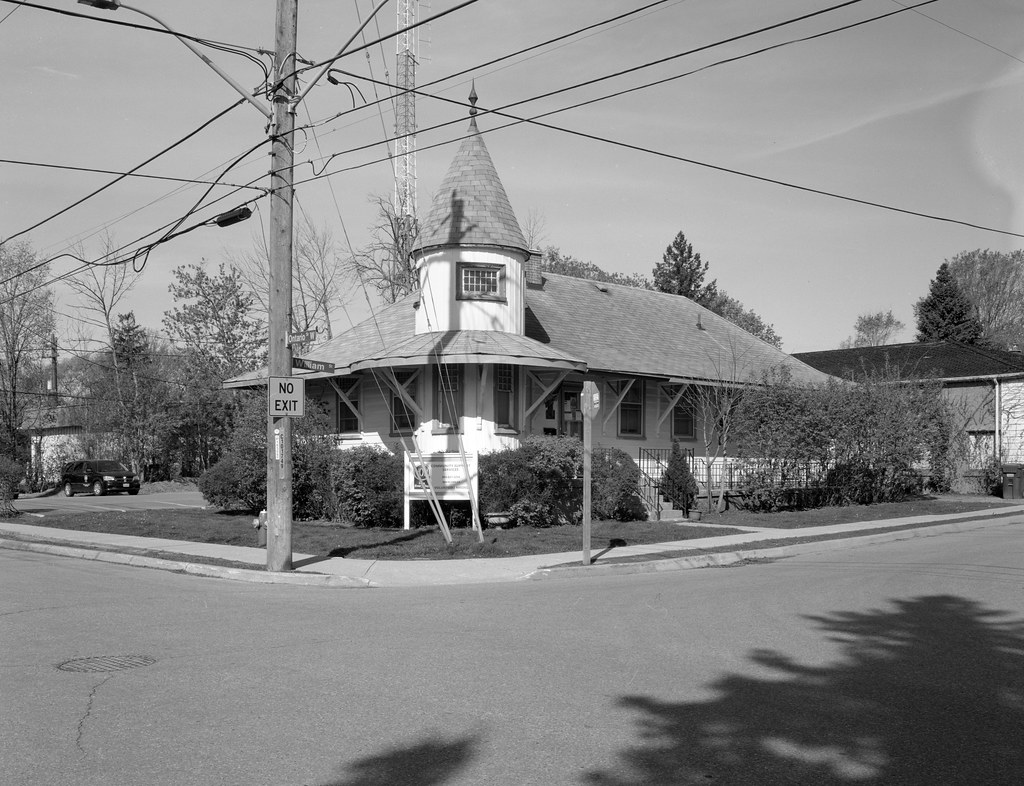Off the main street of the historic village of Streetsville, there is a strange building and one that seems a little out of place at first glance. Beyond this strange building are the train tracks; you can see a tall communication tower from behind. While the sign out front declares it an office of the local branch of the Victorian Order of Nurses, everything about the building says that it’s a train station, and you would be right, but this station is not at its original location. In fact, it is several kilometres south of where the Credit Valley Railway line once branched off towards St. Thomas from the mainline out to Orangeville from Toronto.

Graflex Crown Graphic – Fuji Fujinon-W 1:5.6/125 – Ilford HP5+ @ ASA-200 – Pyrocat-HD (1+1+100) 9:00 @ 20C
The Credit Valley Railway is one of three post-confederation railways supported by Toronto business magnate George Laidlaw. Credit Valley would be built at the Standard Gauge, popular among American railroads, unlike his earlier two. Laidlaw originally envisioned running from Toronto to Orangeville as an auxiliary narrow gauge line to Toronto, Grey & Bruce. Originally charted in 1871, the charter was updated two years later to have the option to expand west to St. Thomas and interchange with Canadian Southern Railway, which used standard gauge. The original Credit Valley mainline arrived in Streetsville in 1874, running west from Toronto then north to Orangeville. The branch line out to St. Thomas began at Streetsville, reaching Milton by 1877 and reaching St. Thomas in 1879. Credit Valley faced several financial problems during the construction of its main and branch line. The branch started north of Streetsville near the modern intersection of Britannia Road West and Mississauga Road. Credit Valley built its first station here in 1879, much to the annoyance of the local population as the station was not in the village proper. Victorian in design with a single short tower and wooden board and batten construction. The station featured a single waiting room, station master’s office, which served as a ticket office and telegraph operator bay. The tower allowed for easier sightlines of the trains moving in along three different tracks. Since the station was a junction location, it featured a pair of order boards that outlined the day’s trains. The distance from the town meant the station never saw heavy use, but in response to the local complaints, Credit Valley did construct a small shed type station further south and in the downtown of Streetsville at the foot of Old Station Road. In 1883 Ontario & Quebec leased the entire Credit Valley network, and a year later, Canadian Pacific led the entirety of Ontario & Quebec’s holdings. Canadian Pacific extended the line from St. Thomas to Windsor, becoming the main line for Canadian Pacific, while Orangeville became a small branch line.

Nikon D750 – AF-S Nikkor 28-70mm 1:2.8D
Nikon D750 – AF-S Nikkor 28-70mm 1:2.8D
Starting in the 1890s, Canadian Pacific began an extensive modernization program which including replacing many of the original railway stations that it had acquired through Ontario & Quebec. By this point, both the Streetsville Junction and Streetsville Town stations were beginning to show their age. But because they were not heavily used stations, their replacement would wait until the second decade of the 20th Century. In 1914, Canadian Pacific completed two identical stations to replace the older Credit Valley Stations. These were built in the Prairie style and designed by Montreal architect Edward Maxwell and were far larger and substantial stations with low hipped roofs and brick construction. While the town station was demolished, the Junction station was sold to a resident, Ephriam Evan, who moved it north to the northwest corner of William and Ontario Streets. Ephriam had a sense of local history and did not wish to demolish this piece of local history. Ephriam would convert the old station into a home but maintained its exterior appearance as a railroad station, even keeping the original white paint colour scheme. I’m unsure of when the station transitioned from a residential to a commercial property. But since then, it has served as a local chapter of Habitat for Humanity, Meals on Wheels and currently the Victorian Order of Nurses. The 1914 stations continued to operate as passenger stations until 1961, when Canadian Pacific cut passenger services to Streetsville.

Nikon D750 – AF-S Nikkor 28-70mm 1:2.8D
Nikon D750 – AF-S Nikkor 28-70mm 1:2.8D
The Junction Station received a local historical designation in 1974. Canadian Pacific maintained operations at both stations until 1982, when both were demolished. GO Transit built a modern station to serve the Toronto to Milton line that same year. The Streetsville Station remains one of two original Credit Valley Stations left standing in Ontario. The second one, located in Milton, Ontario, was replaced in 1914 by a modern brick station. Like Streetsville, it was purchased by a resident and moved to Commercial Street. While it’s a little harder to recognize today as it is set to further back and has seen plenty of additions, it still maintains many of the features of the train station, notably the short tower at the corner. Ironically, Canadian Pacific maintains a small office and service vehicle garage behind the original Junction station. It is still within sight of the Credit Valley rail line it once served.